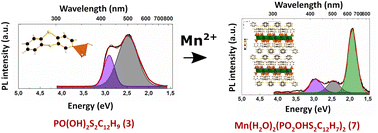A new series of magnetic and luminescent layered hybrid materials obtained from thianthrene phosphonic acid: M(H2O)PO3-S2C12H7 (M = Cu, Zn) and M(H2O)2(PO2OH-S2C12H7)2 (M = Mn, Co)†
Abstract
Four new metallophosphonates with the chemical formulae M(H2O)PO3-S2C12H7 (M = Cu, Zn) and M(H2O)2(PO2OH-S2C12H7)2 (M = Mn, Co) were synthesized using a hydrothermal route from the original bent rigid thianthrene-2-ylphosphonic acid (TPA). This organic precursor crystallizes in a non-centrosymmetric space group P212121 and presents a unique bent geometry due to the presence of two sulfur atoms in its rigid platform architecture. Obtained as single crystal and polycrystalline powders, the structures of the four hybrid materials were solved using X-ray diffraction on single crystals in a monoclinic P21/c space group. These compounds adopt a lamellar structure consisting of one inorganic subnetwork alternating with a ‘sawtooth’ double organic –S2C12H7 subnetwork. The inorganic layers of these compounds are made of (PO3C) or partially deprotonated (PO2OHC) tetrahedra connected by the apices to isolated ZnO3(H2O) tetrahedra, Cu2O6(H2O)2 copper dimers and cobalt and manganese MO4(H2O)2 octahedra, where the latter two exhibit an isotype structure. Thermogravimetric analysis was performed to confirm the amount of water molecules present in the formula, to track the dehydration process of the structures, and to evaluate their thermal stability. The magnetic properties of the copper, cobalt, and manganese-based materials were investigated from 2 K to 300 K by using a SQUID magnetometer revealing dominant antiferromagnetic interactions with Weiss temperatures of −8.0, −10, and −1 K, respectively. These magnetic behaviors were further corroborated by first-principles simulations based on Density Functional Theory (DFT). Finally, the absorption and photoluminescence properties of both the ligand and hybrid materials were investigated, revealing diverse excitation and recombination mechanisms. The organic moiety based on thianthrene significantly influenced the absorption and emission, with additional peaks attributed to transition metals. Singlet and triplet states recombination were observed, accompanied by an unidentified quenching mechanism affecting the triplet state lifetime.



 Please wait while we load your content...
Please wait while we load your content...